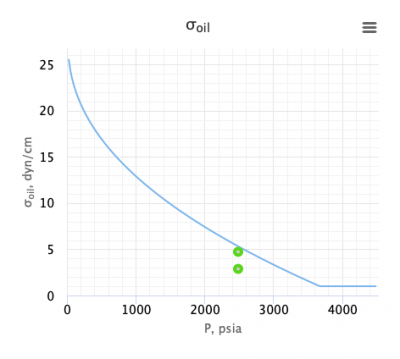Difference between revisions of "Gas/Oil Interfacial Tension"
From wiki.pengtools.com
(→Math and Physics) |
|||
| (14 intermediate revisions by the same user not shown) | |||
| Line 4: | Line 4: | ||
[[Gas/Oil Interfacial Tension]] correlation was published by '''Baker and Swerdloff''' in '''1956'''. | [[Gas/Oil Interfacial Tension]] correlation was published by '''Baker and Swerdloff''' in '''1956'''. | ||
| − | [[File:Gas | + | [[File:Gas-Oil Interfacial Tension.png|thumb|right|400px|Gas/Oil Interfacial Tension correlation in the PVT software at pengtools.com]] |
==Math and Physics== | ==Math and Physics== | ||
| Line 11: | Line 11: | ||
:<math> \sigma_{100} =37.5 - 0.2571 SG_{oAPI}</math> | :<math> \sigma_{100} =37.5 - 0.2571 SG_{oAPI}</math> | ||
| − | :<math> At\ T<68F,\ \ | + | :<math> At\ T<68F,\ \sigma_{od}=\sigma_{68}</math> |
| − | :<math> 68F<T<100F,\ \ | + | :<math> At\ 68F<T<100F,\ \sigma_{od}=\sigma_{68} + \frac{(T - 68) * (\sigma_{100} - \sigma_{68})}{ (100 - 68)}</math> |
| − | :<math>At\ T>100F,\ | + | :<math>At\ T>100F,\ \sigma_{od}=\sigma_{100}</math> |
| − | + | :<math> \sigma_{o}=\sigma_{od} \times (1-0.024P^{0.45})</math> | |
| − | :<math> \ | + | The interfacial tension becomes zero at miscibility pressure. 1 dyne/cm is used for calculations, then it becomes less than 1. |
| + | :<math> if (\sigma_{o}<1) \sigma_{o}=1</math> | ||
== Nomenclature == | == Nomenclature == | ||
| − | :<math> | + | :<math> P </math> = pressure, psia |
| − | :<math> | + | :<math> SG_{oAPI} </math> = oil specific gravity, °API |
| − | :<math> \ | + | :<math> \sigma_{o} </math> = gas/oil interfacial tension, dynes/cm |
| + | :<math> \sigma_{od} </math> = gas/oil interfacial tension for dead oil, dynes/cm | ||
| + | :<math> T </math> = temperature, °F | ||
| + | |||
| + | ==See also== | ||
| + | [[Gas/Oil Interfacial Tension]]<br/> | ||
| + | [[Gas/Water Interfacial Tension]] | ||
== References == | == References == | ||
| − | Baker, O. and Swerdloff, W. 1955. Calculation of Surface Tension 3—Calculating parachor Values. Oil Gas J. (5 December 1955): 141. | + | Baker, O. and Swerdloff, W. 1955. Calculation of Surface Tension 3—Calculating parachor Values. Oil Gas J. (5 December 1955): 141.<br/> |
Baker, O. and Swerdloff, W. 1956. Calculation of Surface Tension 6—Finding Surface Tension of Hydrocarbon Liquids. Oil Gas J. (2 January 1956): 125. | Baker, O. and Swerdloff, W. 1956. Calculation of Surface Tension 6—Finding Surface Tension of Hydrocarbon Liquids. Oil Gas J. (2 January 1956): 125. | ||
| Line 32: | Line 39: | ||
|titlemode= replace | |titlemode= replace | ||
|keywords=Water salinity, TDS, brine salinity, formation water salinity, Water formation volume factor | |keywords=Water salinity, TDS, brine salinity, formation water salinity, Water formation volume factor | ||
| − | |description=Gas/Oil Interfacial Tension | + | |description=Gas/Oil Interfacial Tension correlation was published by Baker and Swerdloff in 1956. |
}} | }} | ||
[[Category:PVT]] | [[Category:PVT]] | ||
[[Category:pengtools]] | [[Category:pengtools]] | ||
Latest revision as of 22:02, 29 December 2023
Gas/Oil Interfacial Tension
Gas/Oil Interfacial Tension correlation was published by Baker and Swerdloff in 1956.
Math and Physics
The interfacial tension becomes zero at miscibility pressure. 1 dyne/cm is used for calculations, then it becomes less than 1.
Nomenclature
 = pressure, psia
= pressure, psia = oil specific gravity, °API
= oil specific gravity, °API = gas/oil interfacial tension, dynes/cm
= gas/oil interfacial tension, dynes/cm = gas/oil interfacial tension for dead oil, dynes/cm
= gas/oil interfacial tension for dead oil, dynes/cm = temperature, °F
= temperature, °F
See also
Gas/Oil Interfacial Tension
Gas/Water Interfacial Tension
References
Baker, O. and Swerdloff, W. 1955. Calculation of Surface Tension 3—Calculating parachor Values. Oil Gas J. (5 December 1955): 141.
Baker, O. and Swerdloff, W. 1956. Calculation of Surface Tension 6—Finding Surface Tension of Hydrocarbon Liquids. Oil Gas J. (2 January 1956): 125.








